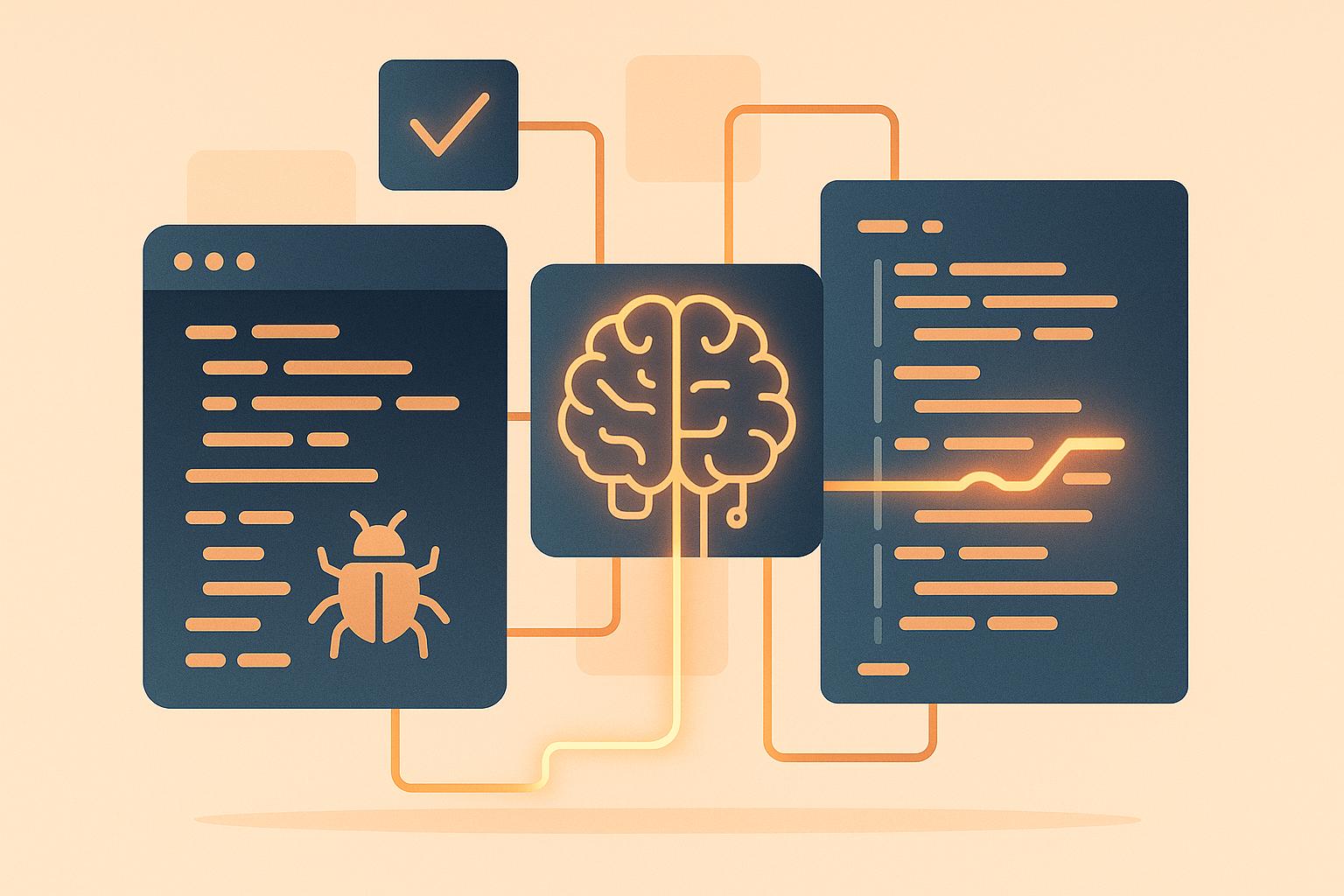
How AI Detects and Fixes Bugs in Code
AI is transforming how software bugs are detected and resolved, offering faster, smarter solutions to manage complex codebases. By leveraging machine learning, pattern analysis, and historical bug data, AI tools can identify up to 95% of bugs, reduce testing time by 50–70%, and even generate automated fixes. These systems integrate seamlessly into development tools like IDEs and CI/CD pipelines, making them an efficient addition for developers. For Canadian businesses, this technology ensures compliance with local regulations like PIPEDA while improving software reliability and reducing downtime.
Key Takeaways:
- Bug Detection: AI uses static and dynamic code analysis, predictive models, and NLP to identify issues early and prioritize fixes.
- Automated Fixes: Tools like DeepCode and Tabnine generate patches, validate them, and update codebases in real time.
- Integration: AI works within existing workflows, enhancing tools like Visual Studio Code, GitHub, and CI/CD pipelines.
- Regulatory Compliance: Canadian companies benefit from AI systems designed to meet PIPEDA and provincial standards.
AI-driven bug detection isn’t just about finding problems – it’s about preventing them and building reliable systems for the future.
AI Code That Fixes Itself (An MCP You Can Try Now)
Main AI Methods for Finding Bugs
AI employs techniques like static code review, dynamic monitoring, predictive models, and natural language processing (NLP) to uncover software bugs. Developers across Canada can choose tools that best suit their specific needs. Let’s break down these methods and how they work.
Static and Dynamic Code Analysis
Static code analysis involves examining source code without actually running it. Traditional tools rely on predefined rules, but AI-powered versions take it further by using extensive datasets of code and bug patterns. These systems can pinpoint real issues while cutting down on false alarms. For instance, AI-driven static analysis tools integrate with code repositories to provide real-time bug detection alongside contextual suggestions. This approach has been shown to boost accuracy by 17.5% while reducing false positives by 60%.
On the other hand, dynamic analysis focuses on monitoring software while it’s running. This method identifies runtime issues that occur under specific conditions. Machine learning models enhance this process by spotting unusual patterns in program execution, memory usage, or system calls – issues that might otherwise go unnoticed by human testers. This is particularly helpful for Canadian businesses handling high-traffic systems during peak periods.
Predictive Models for Error Detection
Predictive models rely on historical data – like commit histories and bug reports from Canadian development environments – to identify areas of code that are more likely to contain bugs. According to a 2021 Rollbar survey, organisations using AI-driven predictive models achieved bug detection rates of 90–95%, while reducing testing time by 50–70%. These models help teams zero in on high-risk code sections, allowing them to focus their efforts where it counts most. This is especially important in industries where software failures could lead to compliance issues or other serious consequences.
Natural Language Processing for Bug Reports
NLP simplifies the bug triage process, which is essential for meeting Canadian development standards. Bug reports often contain valuable insights buried in unstructured text, such as developer comments, user feedback, and troubleshooting notes. NLP tools extract this information and turn it into actionable tasks. These systems can categorise issues, detect duplicate reports, and even recommend the best team member to address a bug based on past performance. For example, BugHerd uses AI to detect duplicate reports and facilitate real-time collaboration, allowing teams to focus on solving problems instead of wading through administrative tasks.
| Method | What It Does | AI Enhancement | Key Benefit |
|---|---|---|---|
| Static Analysis | Scans source code without running it | Reduces false positives with ML | Catches bugs before deployment |
| Dynamic Analysis | Monitors code behaviour during execution | Adapts to runtime changes with AI | Identifies runtime issues |
| Predictive Models | Analyses historical data to flag risks | Finds patterns using ML | Prevents bugs proactively |
| NLP Processing | Processes textual bug reports and feedback | Extracts insights using ML | Speeds up bug triage |
Combining these AI methods leads to the best results. For example, static analysis can be used during code reviews, dynamic analysis during testing, predictive models for risk management, and NLP for handling bug reports. This layered approach ensures bugs are caught at every stage, from initial coding to post-deployment monitoring.
How AI Fixes Bugs Automatically
Once bugs are identified, AI takes over with automated patch creation and resolution. These tools don’t just stop at detection – they generate fixes, test them, and update the codebase. This shift allows Canadian development teams to move from simply reacting to issues to proactively resolving them.
Automated Debugging and Code Generation
AI debugging tools combine program synthesis and machine learning to craft code fixes tailored to the detected issue. By analysing the context of a bug and referencing past solutions, these tools can generate patches in real time, even as developers are writing code.
Take DeepCode and Microsoft IntelliCode as examples. DeepCode uses static code analysis powered by AI to detect bugs and suggest fixes, complete with contextual explanations. Meanwhile, Microsoft IntelliCode offers smart code suggestions based on patterns it has learned from millions of repositories.
Another standout is Tabnine, which uses vast code datasets to provide auto-completions and corrections as developers type. This proactive approach helps prevent bugs before they even appear. A Canadian tech startup that integrated Tabnine into its workflow in 2023 saw a 30% boost in productivity and a 20% reduction in code review time.
Once patches are generated, AI validates them through unit, integration, and simulation tests to ensure no new issues arise. This combination of proactive detection and automated fixes significantly speeds up the development process.
Learning from Past Fixes
AI doesn’t just solve problems – it learns from them. By analysing historical bug reports and commit data, AI tools identify patterns and propose effective fixes. Drawing from thousands of similar bugs across projects and programming languages, these tools can recommend solutions that work, especially for repetitive issues that often drain developer time.
In 2023, a financial services company implemented DeepCode in its workflow. The result? A 40% drop in bug resolution time and a 25% decrease in bugs reaching production. The tool excelled at spotting and fixing common coding errors, freeing developers to focus on more challenging tasks.
As Canadian teams adopt new frameworks and technologies, AI tools evolve too. They adapt by learning from past fixes, ensuring their recommendations stay relevant and align with modern coding practices.
Connecting AI with Development Tools
AI seamlessly integrates into the tools developers already use, making it easy for Canadian teams to adopt. Whether it’s an IDE like Visual Studio Code, JetBrains, or Eclipse, or systems like CI/CD pipelines and version control platforms (e.g., GitHub, GitLab), AI tools fit right into existing workflows.
These integrations enable real-time bug detection, contextual suggestions, and automated testing – all within familiar environments. Developers don’t need to juggle multiple tools or learn new interfaces.
| Integration Type | Functionality | Real-Time Benefits | Canadian Advantage |
|---|---|---|---|
| IDE Integration | Code suggestions and fixes as you type | Prevents bugs during development | Supports Canadian English spelling |
| CI/CD Pipeline | Automated testing and patch deployment | Identifies issues pre-production | Meets local compliance standards |
| Version Control | Automated pull request reviews | Simplifies code reviews | Maintains audit trails for regulations |
For example, automated pull request reviews allow AI to flag potential issues and suggest improvements before human reviewers even step in. This reduces the workload for senior developers while maintaining high-quality code standards.
Canadian organisations also benefit from AI tools tailored to their needs. These systems can be configured to follow Canadian English conventions and meet local regulatory requirements, ensuring a smooth integration into existing processes without the need for extensive retraining.
sbb-itb-fd1fcab
Best Practices for AI Bug Detection in Canada
Implementing AI-powered bug detection isn’t just about adopting the latest technology – it’s about thoughtful planning. Canadian businesses need to strike a balance between technical needs and regulatory compliance, all while ensuring their teams can adapt to these new tools. Success hinges on building a strong foundation, following local standards, and collaborating with experienced providers.
Requirements for AI Implementation
For an AI bug detection system to work effectively, it needs three key ingredients: quality datasets, reliable infrastructure, and skilled professionals. Companies must start with well-organized historical bug data and thorough documentation to train machine learning models. Without this, even the most advanced AI tools will struggle to deliver accurate results.
Canadian businesses should plan to allocate between CAD $50,000 and $200,000+ annually for computing resources, secure data storage, and CI/CD integration. The infrastructure must also accommodate continuous learning, as AI models will need to process growing volumes of code and bug data over time.
Skilled personnel, like data scientists, software engineers, and QA professionals, are essential for a smooth transition to AI-driven workflows. These experts need targeted training to adapt to and make the most of AI tools.
A smart starting point? Begin with non-critical projects. This allows teams to get comfortable with AI integration without risking production systems. Developers can learn how to interpret AI-generated suggestions, filter out false positives, and gain confidence before moving on to mission-critical applications.
Many Canadian companies have found success by blending AI tools with traditional static analysis methods at first. As their datasets improve, they gradually shift toward AI-driven approaches. Having high-quality historical data is critical – not just for technical performance but also for meeting Canadian regulatory standards. This dual focus creates a solid foundation for compliance-conscious practices.
Following Canadian Standards
While technical precision is vital, aligning with Canadian regulatory standards is equally important. Companies must navigate a complex web of regulations when implementing AI bug detection systems. For instance, PIPEDA (Personal Information Protection and Electronic Documents Act) governs how developer data, code repositories, and customer information in bug reports are managed. In Quebec, Bill 64 introduces additional requirements around consent and transparency in how AI systems handle code.
Industry-specific regulations add another layer of complexity. Healthcare software must comply with provincial health privacy laws, while financial applications require stringent security measures and audit trails. Public sector organisations face heightened scrutiny regarding data sovereignty and transparency in AI decision-making.
Data residency is a cornerstone of compliance. It’s essential to choose AI tools that allow code and bug data to remain within Canada or specific provinces. To further strengthen compliance, implement encryption for data in transit and at rest, conduct regular security audits, and maintain detailed documentation of how AI systems access, process, and store code. This documentation is invaluable during audits, especially in regulated industries.
When using cloud-based AI tools, establish clear contracts that outline data handling, breach notifications, and compliance responsibilities. Addressing these details early can help avoid risks and ensure regulatory alignment.
Working with Digital Fractal Technologies Inc

Navigating the technical and regulatory hurdles of AI bug detection can be daunting, which is why partnering with seasoned experts is so important. Digital Fractal Technologies Inc offers tailored solutions to help Canadian companies integrate AI-driven bug detection systems effectively.
With a strong track record in the public sector, energy, and construction industries, Digital Fractal Technologies Inc understands the unique challenges Canadian businesses face. Their AI systems are designed to meet PIPEDA standards while addressing the specific needs of regulated industries, balancing innovation with compliance.
Their services go beyond just implementing AI tools. They create custom bug detection solutions that fit seamlessly into existing CI/CD pipelines and established development workflows. This eliminates the need for teams to adapt to generic tools, making the transition smoother and more efficient.
Digital Fractal Technologies Inc also provides custom CRM and business management tools to track bug detection metrics, manage workflows, and offer analytics dashboards. These tools make it easier for companies to measure ROI and improve their AI systems over time.
Additionally, they help businesses develop internal policies and frameworks for AI use. Their focus on data sovereignty and accountability ensures alignment with Canadian regulations, easing the compliance burden and simplifying audit processes.
| Service Area | Digital Fractal Expertise | Canadian Advantage |
|---|---|---|
| AI Implementation | Custom AI solutions, workflow automation | Meets PIPEDA and provincial requirements |
| Industry Knowledge | Public sector, energy, construction | Understands regulated industry needs |
| Ongoing Support | Continuous optimization, metric tracking | Ensures long-term compliance and performance |
Conclusion: Changing Software Development with AI
AI-powered bug detection is reshaping software development in Canada. These systems can identify up to 95% of bugs, cut manual testing efforts by 30%, and slash overall testing time by 50–70%, all while reducing false positives by 60%. The result? Fewer production issues, reduced downtime, and a smarter use of developer resources – key advantages in Canada’s highly competitive tech sector.
The Future of AI in Canadian Software Development
The role of AI in Canadian software development is evolving rapidly, with a clear trend toward deeper integration and smarter systems. Instead of reacting to issues, AI now focuses on preventing them by predicting defects before they occur. Leveraging historical data, these systems are driving smarter resource allocation and fostering a development process that improves continuously over time.
Some Canadian companies are already seeing these advancements in action. For instance, in 2024, a public sector organisation in Ontario implemented an AI-powered bug detection tool, leading to a 35% drop in critical bugs reaching production and a 50% reduction in manual code review time. Similarly, in 2023, a Canadian energy company integrated DeepCode into their workflow, achieving a 40% reduction in bug-related downtime and cutting manual testing hours by 25% in just six months.
As digital transformation sweeps through industries across Canada, incorporating AI into development and testing workflows is no longer optional. It’s becoming essential for creating reliable software efficiently, all while keeping pace with changing regulations and customer expectations. These advancements highlight the growing importance of expert guidance in making the most of AI technologies.
Digital Fractal Technologies Inc: Your AI Partner
Harnessing the full potential of AI-driven bug detection requires more than just adopting new tools – it demands expertise in advanced technology and an understanding of Canada’s unique regulatory landscape. That’s where Digital Fractal Technologies Inc comes in.
Specialising in AI consulting and software development tailored to Canadian industries like public sector, energy, and construction, Digital Fractal Technologies Inc offers solutions that not only improve technical performance but also ensure compliance with local standards. Their scalable applications integrate seamlessly into existing workflows, featuring tools such as custom CRM systems and business management dashboards to track bug detection metrics, streamline processes, and deliver actionable insights.
FAQs
How do AI tools detect and fix code bugs while ensuring compliance with Canadian regulations like PIPEDA?
AI-powered tools leverage sophisticated algorithms to spot and fix bugs in software code by analysing patterns, identifying irregularities, and suggesting solutions. What’s more, these tools can be tailored to meet Canadian regulations, such as PIPEDA, by embedding data privacy and security measures directly into the bug detection workflow.
For instance, AI systems can track how sensitive data is managed within the code, helping to prevent potential breaches or misuse. By following privacy-by-design principles, these tools not only improve software quality but also ensure compliance with regulatory standards. This allows businesses in Canada to simplify the debugging process while staying aligned with legal requirements.
What are the benefits of using AI for bug detection in software development workflows for Canadian businesses?
Integrating AI-driven bug detection systems into your development workflow brings a host of benefits for Canadian businesses. These tools excel at spotting coding errors faster and with greater precision compared to manual methods. This means less time spent on debugging and more time for your team to focus on creating and refining innovative solutions. On top of that, AI systems can anticipate potential problems before they arise, which helps bolster the reliability of your software.
For companies in Canada, these systems also play a role in ensuring adherence to local regulations and standards. By automating repetitive tasks, businesses can cut costs and shorten project timelines. The result? Increased efficiency, higher productivity, and a better experience for your customers.
How does AI analyse past bug data and use machine learning to predict and prevent errors in complex codebases?
AI uses historical bug data combined with machine learning models to spot patterns and recurring issues in software code. By studying these patterns, it can anticipate potential errors in both new and existing codebases, even when dealing with highly intricate systems.
Machine learning algorithms are trained on extensive datasets that include code samples and bug reports. This training allows them to identify irregularities, recommend solutions, and even automate parts of the debugging process. This forward-thinking method cuts down on troubleshooting time while enhancing the reliability and efficiency of software development projects.

